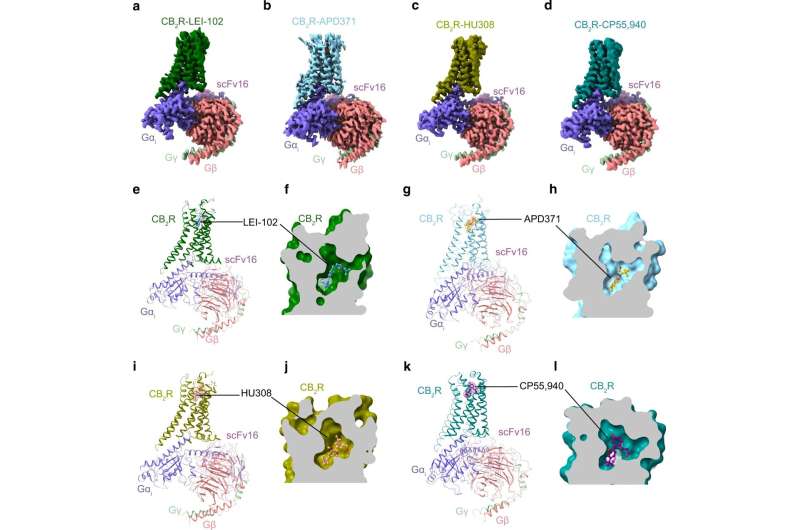Cryo-EM structures of CB2R-Gi complexes. Cryo-EM density maps of a LEI-102 (Dark green), b APD371 (Sky blue), c HU308 (Olive), and d CP55,940 (Teal) bound CB2R in complex with Gαi (Slate), Gβ (Salmon), Gγ (Pale green), scFv16 (Violet purple). e–l Overall structures of CB2R-Gi complexes and enlarged view of orthosteric pocket of f LEI-102, h APD371, j HU308, and l CP55,940 using the same color codes as (a–d), with agonists shown as cornflower blue (LEI-102), orange (APD371), dark salmon (HU308) and purple (CP55,940) sticks, respectively. Credit: Nature Communications (2023). DOI: 10.1038/s41467-023-37112-9
Chronic pain, nausea or vomiting due to chemotherapy. If you suffer from such ailments, medicinal cannabis can be a godsend. Though a downside is that it can make patients high. Therefore, Leiden researchers from the Oncode Institute are investigating alternatives that do not make you high. In Nature Communications, they published an important breakthrough.
THC, the active substance in cannabis, affects your body in two ways. Best known is its effect on your brain, where it will make you feel high. But it also affects your immune system. The latter is what makes medicinal cannabis useful. That's why pharmaceutical companies are looking for substances that only affect the immune system, without causing the effects in the brain. This could provide the medicinal effects, but without getting you high.
A key piece of the puzzle is the so-called CB2 receptor in the immune system that THC acts on. In collaboration with international researchers, Leiden scientists have now investigated the molecular structure of this receptor. Using a special microscope, they saw exactly how synthetic cannabinoids bind to the CB2 receptor. This allowed them to find out how different candidate drugs activate the immune system but not the brain, where mainly CB1 receptors are found.
"It is important for us to look at how the candidate drugs work," says co-author and Leiden professor Laura Heitman. "In doing so, we discovered big differences between CB1 and CB2 receptors." Using genetic techniques, the researchers then altered the receptors to study them more thoroughly. "We made some very interesting discoveries that will help us design better drugs in the future," Laura Heitman concludes.
The researchers also discovered that the CB2 receptor has two entry points. Body-specific and fat-soluble cannabinoids use the "side entrance," while more water-soluble cannabinoids enter through the receptor's "main entrance."
"Water-soluble substances generally show fewer side effects and can simply be ingested through a pill," Leiden professor and co-author Mario van der Stelt explains. "We can now specifically design new drugs with better properties that target the main entrance."
More information: Xiaoting Li et al, Structural basis of selective cannabinoid CB2 receptor activation, Nature Communications (2023). DOI: 10.1038/s41467-023-37112-9
Journal information: Nature Communications
Provided by Leiden University























